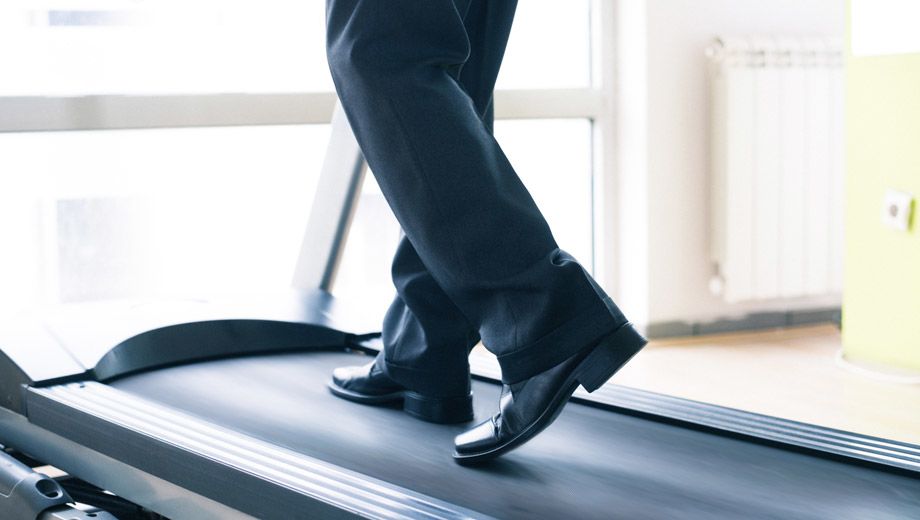America’s airports are where long lines, crowds, and the TSA combine to make life miserable. But once the metal detectors, explosives-sniffers, and pat-downs are behind you, suddenly all is transformed into boutiques, bars, and restaurants.
Why not gyms, too?
The airport terminal has long been lucrative commercial real estate, thanks to a captive audience. For those who have hours to wait, there’s not much else to do except shop, drink, and eat.
So two graduate business students at the University of Oregon started wondering whether an airport gym could thrive in such a setting. After researching the airport and fitness industries, Cynthia Sandall and Ty Manegold concluded that the only obstacle is mainly cost - not because air travelers consider it ridiculous. Thus, a business model was born.
Its name is Roam Fitness, which opened its first airport location in January at Baltimore Washington International, with a goal of adding two airports this year. Now, to make a terminal gym remotely feasible, most prospective customers need to be provided workout clothes and enough time not to stress over missing a flight, Roam’s founders said.
A US$25 day pass includes rental clothes and shoes, a shower, and if you bring your own workout gear, vacuum sealing so it doesn’t stink up the cabin.
Even as massage, spa, and yoga spaces have become airport staples, the full-service gym has a very limited history. Five years ago, San Francisco International Airport led the way with a yoga space, which proved popular, and airports including Chicago-O’Hare, Dallas-Fort Worth and Burlington, Vermont, followed.
“It has been attempted in the past, but in our minds just not very well-executed,” Manegold, who serves as Roam's president, said Wednesday in an interview. “A lot of people did a copy-and-paste of a street version of a gym. And that really doesn’t translate that well because of the economics involved.”
By economics, Manegold is referring to the unique costs associated with such an endeavor. There’s the steep outlay for equipment and facilities, including apparel, laundry, and shower accoutrements, plus the various higher expenses associated with operating in such a highly regulated environment, which Mangold said is roughly five times that of, say, a strip mall.
“The cost of building in an airport is astronomical, compared to street level,” said Sandall, who is also chief marketing officer. The two partners of the Eugene, Oregon-based company nevertheless managed to raise about US$1.5 million, mainly from friends and family, before the first location opened.
Creating a flyer-friendly gym
As a commercial enterprise, airport fitness has a few core requirements, according to Roam.
First, an airport gym needs a sufficient number of business travelers at major hubs – gateways that serve at least 1 million passengers annually. The emphasis is on sky warriors rather than leisure travelers, since the latter tend to be more prone to indulgence than sets of squats.
Second, the gym must be be situated beyond the Transportation Security Administration checkpoints, since clearing the screening is a traveler’s highest priority. The allure of products or services that lay past it is decidedly secondary.
And third, the airport landlord must believe that the gym is part of a larger whole, helping to soothe harried travelers and boost spending elsewhere in the terminal. This is because, on a revenue-per-square-footage basis, an airport gym will never compete with a sit-down restaurant, Sandall said. And this may be the concept’s biggest problem.
“Our airport has one of the smallest footprints in the country,” said Brian DeRoy, a spokesman for Seattle-Tacoma International Airport, which serves 46 million people annually. “Since space is at a premium in any airport, the business side kicks in.... how many people would utilize the gym for it to make money, compared with a restaurant or shop? That’s likely the biggest reason there aren’t more gyms at airports."
Roam’s Manegold concedes that large airport retail models aren’t “conducive to mom-and-pop shops.” But he counters that there are other, less tangible benefits to putting a gym into the mix.
“That large restaurant will do more revenue than we can do,” he added. But “the less stress that people have in a mall, an airport, any shopping environment, the more money they spend.”
Up next: yoga at Heathrow?
This fall, another start-up, FlyFit Global, plans to open what it says is the first airport yoga and wellness studio – with a shower included in the fee – at London’s Heathrow Airport, also an investor in the project.
The yoga center will be in Terminal 2, which houses most of the Star Alliance airlines. The space will offer travelers instructor-led classes, plus interactive strength, restorative and cardio classes.
Currently, Roam sees about 20 customers per day, who exercise for about 30 minutes and then use the shower. An even larger number of passengers drop in to ask questions about the gym, pledging to return for a workout next time, Manegold said. Roam believes its service will appeal more to millennial travelers and Gen-Xers, less to aging baby boomers.
In addition to the two additional outposts planned for later this year, Roam is trying to raise funds for a eventual expansion to at least 20 airports. “When we started this, we were kind of dating the airports,” Manegold said, “and now the airports are dating us.”
Still, the company might want to follow FlyFit’s lead – at least if they want to land in Seattle. Said DeRoy: “Since we’re Seattle and a little quirky by nature, we’d likely be more inclined to have a yoga room.”


